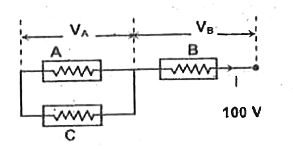If two buibs of 25 W and 100 W rated at 400 V are connected in series across a440 V supply, will both the bulb fuse? If not, then which one ?
(b) Two bulbs rated at 60 W and 100 W (220 V) are connected (i) in series and (ii) in parallel. Find the heat dissipated in the bulbs and also the total heat dissipatedin the circuit.
(c) A heater is designed to operate with a power of1000 watts in a 100 volt line. It is connected with an identical heater (B) in series and a100 V second heater (C) in parallel as shown. What should be the resistance of C so that the heater A may operate at a power level of 62.5 watts, if the entire combination is connected across a 100 V line

Text Solution
As resistance of the bulbr r=V2sWand specified voltage is same, then
(R25R100=10025=4,i.e.R25=4R
The bulbs are connected in series V25=R25R100+R25V=45×440=352V
V100=R100R100+R25V=15×440=88V
Thus, neither will fuse.
(b)P1=(V20R160W,P2=V2r2=100V
When the bulbs are connected in parallel, a p.d. of 220 V appears across each bulb. The power dissipated is: 60 W and 100 W and the total power dissipated is 160 W. When the bulbs are connected in series, the same current flows through them
thereforeR1 =V2P1andR2+9V2)P2give the resistances(V=220V)
The current in the bulbs is
i=VR1+R2
and the power dissipated in the two bulbs as well as the total heat dissipated are, respectively, i2R1.i^(2)R2 and I2(R1+R2)
ORv2R1(R1+R2)2
V2(R1+R2)2andV2(R1+R2)
or1/P1(1P1+1p2)2
1/P2(1P1+1p2)2and11P1+1P2<br>Theresistanceofheater<br>R_(A)=(100xx100)/(1000)=10Omega<br>Now,calca––tethepotentiald⇔erenceacrossAwhenitisco∩ected∈thegiven∘uit<br>i.eV_(A)^(2)=62.5xx10<br>orVA=25V
As the applied voltage is 100V,i.e.VA+Ve=100 ⇒ VB=100−25=75V
Hence, circuit current = (V_(B))/(R_(B))=(75)/(10)=7.5A<br>IfR_(C)istheunknownresistance,then<br>I-(A)+I_(C)=(V_(A))/(R_(A))+(V_(C))/(R_(c))<br>Now,I=7.5A,V_(A)=V_(C)=25V,R_(A)=10Omega<br>7.5(25)/(10)+(25)/(R_(C))<br>Hence,R_(c) = 5Omega.

|
Topper's Solved these Questions
- CURRENT ELECTRICITYBOOK - FIITJEECHAPTER - CURRENT ELECTRICITYEXERCISE - Comprehension Based Type-1
3 Videos
- CURRENT ELECTRICITYBOOK - FIITJEECHAPTER - CURRENT ELECTRICITYEXERCISE - Comprehension Based Type-2
2 Videos
- CURRENT ELECTRICITYBOOK - FIITJEECHAPTER - CURRENT ELECTRICITYEXERCISE - SOLVED PROBLEMS (OBJECTIVE)
20 Videos
- COLLISION BOOK - FIITJEECHAPTER - COLLISION EXERCISE - (NUMERICAL BASED QUESTIONS)
4 Videos
- ELASTICITY AND WAVES BOOK - FIITJEECHAPTER - ELASTICITY AND WAVES EXERCISE - Assignment Problems (Objective) Level-II
15 Videos
Similar Questions
Knowledge Check
If two bulbs of 25 W and 100 W, rated at 220 V, are connected in series across a 440 V supply
A25 W bulb will fuseB100 W bulb will fuseCnone will fuseDboth will fuseIf two bulbs of 25 W and 100 W rated at 200 volts are connected in series across a 440 volts supply, then
A100 watt bulb will fuseB25 watt bulb will fuseCnone of the bulb will fuseDboth the bulbs will fuseTwo electic bulbs marked 25W−220V and 100W−220V are connected in series to a 440 V supply. Which of the bulbs will fuse?
ABothB100 WC25 WDNeither
If two bulbs of 25 W and 100 W rated at 200 volts are connected in series across a 440 volts supply, then
View SolutionTwo electic bulbs marked 25W−220V and 100W−220V are connected in series to a 440 V supply. Which of the bulbs will fuse?
View SolutionTwo bulbs having rating of 60 W, 220 V and 100 W, 220 V are joined (i) in series, (ii) in parallel. Which of the two will glow brighter in each case?
View SolutionTwo bulbs having rating of 60 W, 220 V and 100 W, 220 V are joined (i) in series, (ii) in parallel. Which of the two will glow brighter in each case?
View SolutionTwo electric bulbs marked 25W-220V and 100W-220V are connected in series to a 440 V supply. Which of the bulbs will fuse ?
View Solution
